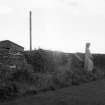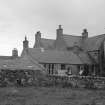Graemeshall
Chapel (Period Unassigned), Gate Pier(S) (Period Unassigned), House (Period Unassigned)
Site Name Graemeshall
Classification Chapel (Period Unassigned), Gate Pier(S) (Period Unassigned), House (Period Unassigned)
Alternative Name(s) Graeme's Hall
Canmore ID 133438
Site Number HY40SE 40
NGR HY 48738 01719
Datum OSGB36 - NGR
Permalink http://canmore.org.uk/site/133438
- Council Orkney Islands
- Parish Holm
- Former Region Orkney Islands Area
- Former District Orkney
- Former County Orkney
HY40SE 40.00 48738 01719
HY40SE 40.01 Centred 48754 01689 South Walled Garden
HY40SE 40.02 48762 01701 Statue
HY40SE 40.03 48765 01691 Statue
HY40SE 40.04 48769 01679 Statue
'The Orkney Herald' in 1896 reported the excavation of a long cist and skeleton at Graemeshall, which may have been in the grounds of this house. It states that the cist was found where an old farmhouse stood, to the N of the present house. It adds that in around 1879 a headless skeleton was found under a millstone on the S side of the old hall courtyard.
M Howe 2006
Field Visit (6 August 1929)
(1) In the private chapel of the mansion-house at Graemeshall, built against the N. wall near the altar, is a rectangular cross-slab of sandstone (ECM, iii, 21-2), found many years ago in the floor of the parish church at Holm and removed to its present position for better preservation. Sculptured in relief on one face only, it is 4 ft. 9 in. in length, while its width is 15 in. at the ends and 1 ft. 4 ½ in. in the middle. Around the edge is a flat moulding, within which a cross, slightly raised above the background, is outlined by a similar but narrower moulding. The cross rises from a square base, and originally the whole design was elaborately ornamented. The upper portion is now very much defaced, but the shaft and base still show clear traces of interlaced work of varied pattern.
(2) In the same chapel is a small sepulchral slab, incised with three swords, found in the churchyard of Holm. The stone is remarkable for the triple sculpturing of the sword, which is of very rare occurrence (PSAS, xxxc, 150). A slab with three swords sculptured in relief at Finlaggan, Islay,is figured in Graham's Carved Stones of Islay, p.29.
RCAHMS 1946, visited 6 August 1929.
Publication Account (1996)
Despite the misfortune of the estate in attempting premature improvement in the early 19th century, the house of Graemeshall today is a gracious mansion in the Scottish style, set in tranquil grounds. It is a double block of two storeys and an attic, with crow stepped gables and mullioned windows, and it was the work of John A Bruce of the Kirkwall firm of Peace Architects. The garden wall retains a moulded arch from the earlier 17th century house, which was designed round a courtyard and incorporated elements going back to the 15th century. This earlier house was originally called Meall but was renamed Graemeshall after it had been accquired by the Graham fami ly in the mid 17th century.
A chapel to St Margaret of Antioch and Scotland was added to the east wing of the 19th-century house in 1898, and it contains an important early Christian graveslab from Holm parish graveyard. The garden is dominated by large statues of Faith, Hope and Charity created in 1868 for a building(since demolished) in Inverness.
Information from ‘Exploring Scotland’s Heritage: Orkney’, (1996).
































